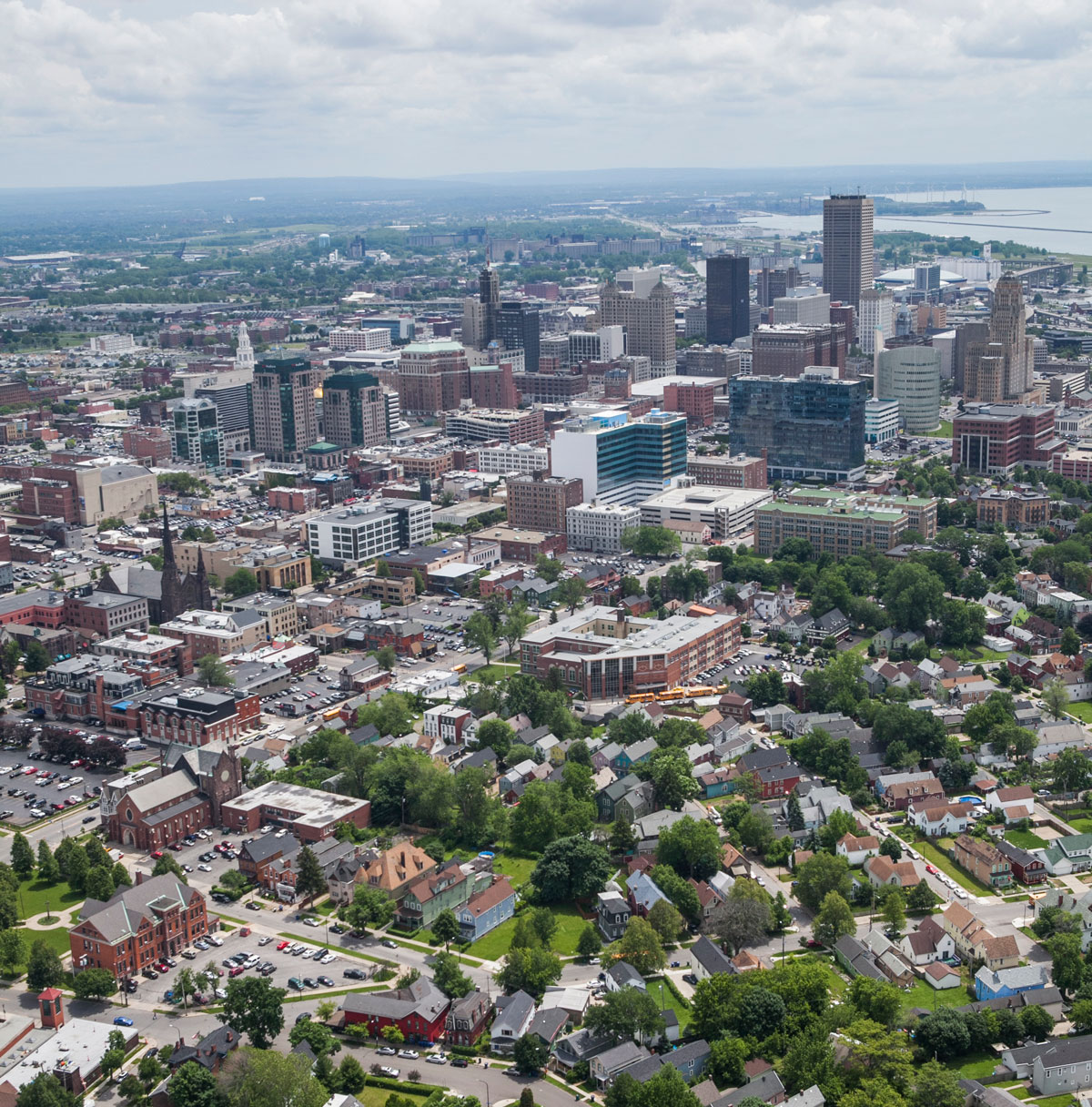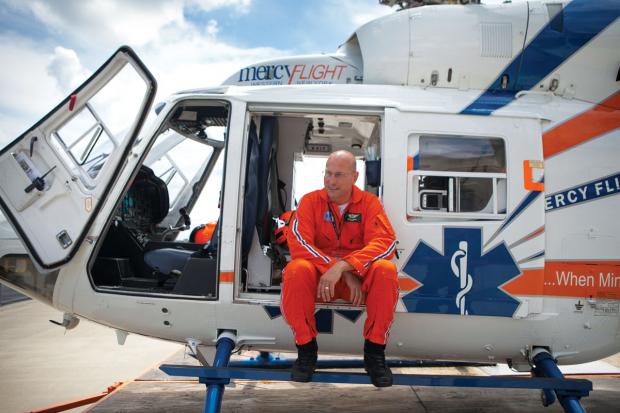Flying With Mercy
In the air
About three minutes into the flight from the airport and we’ve reached the first on our list of flyovers, Woodlawn Beach in Hamburg. Marc Boies, pilot and director of flight operations, tells us through our headsets to brace for a roll right; almost immediately up becomes down, and to my direct left about 700 feet straight down is Lake Erie. Only the helicopter’s G-force and my seatbelt keep my body weight from pushing against the door.

There’s nothing like flying—every human activity (but one, perhaps) pales in comparison. It’s our fate to stumble on the ground on our heavy feet. The demons and angels are equally blessed with wings. Humans, cursed by gravity, have to settle for helicopters skimming close to the ground like dragonflies over water, optimally with the window open on a sunny day full of fluffy white clouds.
The magic of flying and the beauty of a warm and sunny June view over Western New York made me forget that I was in an aerial emergency room, in a space no one ever wants to find themselves by necessity. Near our feet were steel grommets used to lock a stretcher in place, and medical gear was stored neatly in every compartment, an oxygen valve overhead. That first roll right in Mercy Flight 9 induced a moment of joy not available to the helicopter’s usual passengers: one pilot, one paramedic, one flight nurse, and one critically injured or medically fragile patient.
A fainter voice crackling over the headset brings everything into perspective. It sounds like there’s been an auto accident on Millersport Highway, and a request for a possible medevac by Mercy Flight. We return to the base on Aero Drive (in the old Flying Tigers restaurant) within minutes to trade places with two flight staff, who load a stretcher and gear into the helicopter’s clamshell rear doors, the auricle of the aircraft’s insect-inspired design.
Boies keeps the blades spinning as the other two check their gear, get strapped in, and wait for a confirmation to proceed to the scene. In cases such as these, the medical staff is informed of the nature of the injury as the flight operations staff verifies location, landing area, and weather conditions. The control room provides weather and wind updates while maintaining contact with personnel on the scene, who all have training in preparing a landing area for Mercy Flight. Too much fog, or wind, or lightning, for example, can keep Mercy Flight grounded. A moment later, the stretcher is untethered and we switch places again: a false alarm.
A rare bird
Air ambulance services were slowly implemented nationwide in the aftermath of the Vietnam War, as pilots and medics in the habit of saving lives found civilian applications. (For the first time in its 34-year existence, Mercy Flight no longer has pilots with experience in Vietnam—they’ve all retired.) But the service has since become a money-maker for hospitals and companies able to charge exorbitant fees, because who can put a price on a service that may save life or limb? The skies are becoming increasingly crowded.

A recent New York Times investigation reported that the number of medical helicopter programs in the US has skyrocketed since 2000, led by the Colorado-based corporation Air Methods. Last year Air Methods recorded $1 billion in revenue, or about 30 percent of the market share nationally for medevac services.
Information included in the Times piece and corroborated by materials provided by Mercy Flight show that other medevac companies charge upwards of $50,000 for a transport, roughly three times the amount charged on average by Mercy Flight. If patients are unable to pay, Air Methods has been known to file suit or place liens against a patient’s personal assets, including their homes—something that makes Doug Baker visibly ill at ease when the topic surfaces.
Referred to as “Mr. Baker” by most everyone on the Mercy Flight campus, the founder of Mercy Flight cuts an unremarkable profile. He’s a quintessential Western New York Baby Boomer, Midwestern humility mixed with Northeastern compassion, all with the emotional temperament of someone who probably cried when Scott Norwood’s kick sailed wide right, but then was the loudest to chant “Scotty!” the next day in Niagara Square. When people talk about the charitable and friendly spirit of Western New York, they refer to people like Doug Baker: people who do special things yet regard themselves as ordinary.
As for-profit companies crowd the business (and some have made offers to buy Mercy Flight), Baker has stayed true to the organization’s mission that was developed and founded with Sister Sheila Marie Walsh and Margaret Ferrentino at its inception.
“You’re doing something no one else can do and you’re doing it in a nonprofit setting,” Baker explained in the old Flying Tigers dining room overlooking the Buffalo-Niagara Airport’s main runways. “That’s big. So families don’t get destroyed, people don’t lose their houses.”
In the late 1970s, Baker owned LaSalle ambulance and Ferrentino worked for him as an EMT before becoming New York State’s first female paramedic in 1979. Time and again, the two encountered critically injured children in remote areas for whom a longer wait for an ambulance, coupled with a longer ride to hospital, landed them outside the so-called “golden hour” for trauma response that increased their chance of survival.

Baker leased his first helicopter in 1981 with the goal of breaking even, but couldn’t find any hospital willing to provide medical direction to his staff on board due to liability issues. He struck out with three area hospitals before he made a call to Mercy Hospital’s then-director, Sister Sheila Marie Walsh, who currently serves as a governing nun for the Sisters of Mercy. After a 15-minute conversation, Baker was introduced to Dr. Matthew Burke, who, along with Dr. James Ehinger, would play an instrumental role providing medical direction to the fledgling company. Baker decided then to name the service after the order’s guiding virtue. Thirty-four years later, the mission remains unchanged, though the industry has shifted around it.
“When we started up, 99 percent of the companies were nonprofit, and now it’s the other way around,” Baker said, driving a wedge into the problem of having a publicly traded corporation in control of life-and-death decisions. “Their primary concern is the bottom line for their shareholders. Our prime concern is patient care. I can’t do it, I can’t be that way. Sister Sheila Marie Walsh, she instilled in me and Margie [Ferrentino], and maybe it’s corny, but ‘You gotta take care of people.’”
In order to take care of people, Mercy Flight relies on a network of volunteers and an infrastructure for constant fundraising. The walls of the hangar and main base on Aero Drive are lined with photographs of the organization’s history, and the names of the kind souls who have kept the helicopters in the air.
Having sold off the ambulance company in 1995 to Rural/Metro, Baker and Ferrentino focus their energies solely on the business and ambassadorship that Mercy Flight requires. “Without the community support here, the program would be completely different. We’d have to cut back hours of operation, probably cut back on locations. The people who support us year in and year out, it’s just unbelievable. The amount of $5 and $10 donations, and $1 donations…without it, it would be much different thing. And we’d have to also charge like for-profits.”
And that would almost certainly spell the end of Mercy Flight’s charity program for the non- and under-insured, something very close to the organization’s foundational principle. “If you see somebody’s making $9,000 a year and their child got hit by a car, what are you going to do?” Baker says. “We’re not going to put anyone out of their home. I’m telling you, it’s not good business.”
Operations
Mercy Flight operates three bases, one at the Buffalo Airport, one in Batavia, and one in Olean. The distribution puts all of Western New York within a 15-minute flight radius. Each base has a helicopter on 24/7 standby with staff working 12-hour shifts and doctors on call remotely. The fleet comprises five helicopters, which allows them to cycle aircraft for downtime and maintenance, and also a Learjet.
Mercy Flight averages 1,200 missions per year, which are split fairly evenly between emergency calls and patient transports. Pilot Marc Boies impressed the whole crew when he made Dallas, Texas from the Buffalo Airport in two and a half hours on the Learjet for a patient transport a few weeks ago.
The work itself is, of course, severe. “It’s not a lot of fun,” Baker says. “The type of calls you get, especially in the spring, summer, and fall, are tragedies. Tragedies for the patient, tragedies for the family, very emotional on the paramedic or the nurse, or the doc if we;ve got him flying. Unless you’re a non-caring human being, which we don’t have here.”
What they do have are professionals who are able to compartmentalize the trauma in order to better focus on saving lives. Baker says that years back, flight staff were in the habit of calling hospitals to follow up on the condition of patients they transported. Eventually, a doctor, fearing that the staff’s emotional involvement in the process could cloud their judgment, called and asked for the practice to stop.
Donald Trzepacz Jr., director of air medical operations, explains that air paramedics need to be cut from a different, albeit similar, cloth than regular paramedics. A patient’s medical condition has to be severe to necessitate a resource-heavy service like a medevac. Paramedics all come with the same scene-response demeanor that the job requires; the difference surfaces during the flight, when the paramedic and flight nurse operate an on-board intensive care unit. For both inter-facility transfers and emergency calls, they are prepared to operate equipment like heart/lung machines, ECMO machines that oxygenate a patient’s blood, and balloon pumps.
Above all, they need to think on their feet while suspended mid-air. “Our paramedics bring to the table that professional creative thinking in order to respond to an urgent situation,” Trzepacz said.
The fundraising for Mercy Flight operations never stops, and while the organization is able to stay aloft by taking in around $1 million in donations annually, they are looking both to update the fleet and to purchase better flying instruments to enable them to fly in low-visibility weather. Most of their helicopters date back to the 1980s; they hope to purchase a new $7 million twin-engine helicopter and retire one of the older aircraft.
After launching with the goal of breaking even and fending off numerous financial crises along the way, the Mercy Flight leadership knows how to handle those hard rolls and turbulence.
“I feel really good about what we do,” Doug Baker told us. “And I’m very lucky. Sister instilled that in us, and Margie feels the same way. You’ve got to do it right.”





